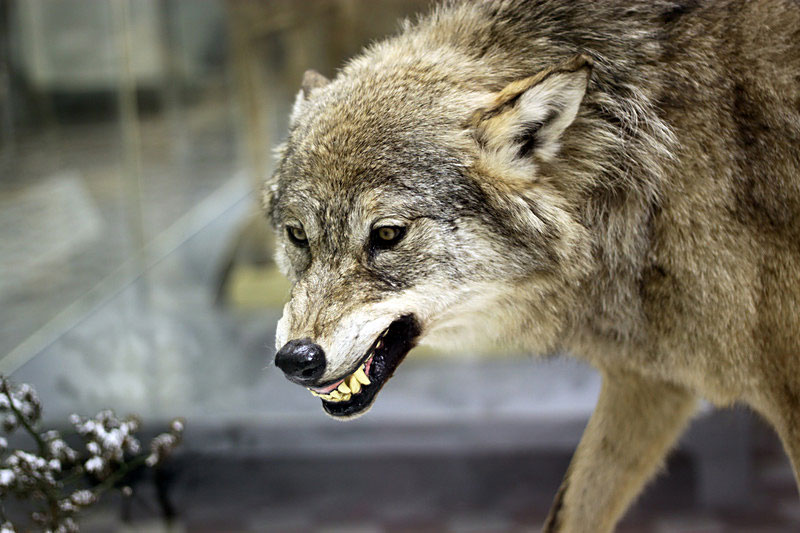Wolves: Separating Myths from Truth
October 23, 2019
For thousands of years, wolves have been looked upon with mistrust and fear. They have starred in fairy tales including “The Boy Who Cried Wolf”, “Little Red Riding Hood”, and “The Three Little Kids” as bloodthirsty villains. They have endured long crusades with the purpose of obliterating them. They have a worse reputation than bears and lions. But are wolves really the monstrous beasts we believe them to be? Studies into their behavior may answer that question.

According to Merriam-Webster dictionary, wolves are any of several large predatory canids (genus Canis) that are active mostly at night, live and hunt in packs, and resemble the related dogs. Wolves’ habitats are in North America, Europe, North Africa, and Asia. Wolves have a prodigious appetite. They can eat up to 20 pounds of food in one meal. Different types of wolves eat different food ranging everywhere from moose to berries.
What are wolves like?
Wolves live in packs and that requires a certain amount of cooperation, loyalty, and faithfulness. In order to upkeep that, wolves have complex social structures consisting of alphas, omegas, betas, and more. Wolves have been noticed to avoid fights. It’s natural that they don’t have a completely hostile nature considering they must live harmoniously among other wolves. However, it’d be a lie to claim wolves are entirely peaceable. They can be aggressive when upholding their status, protecting their pack, and predating prey. Individual wolf behavior depends on their social standing.
Why do they howl?
 Many tales have been spun about wolf howls, werewolves being the most prominent. These stories have been told around campfires for centuries. But how much truth do these stories actually hold? Not much. Wolves howl for two main reasons. The first reason is to convey their whereabouts to the rest of their pack. Why? Wolves claim large territory them and their pack. Sometimes a wolf may temporarily separate from their pack to hunt. Their howls can be heard up to 10 miles away from their position in bare tundra, and only a slightly smaller distance in forest. The second reason to howl is to threaten other rival packs. Wolves are extremely territorial.
Many tales have been spun about wolf howls, werewolves being the most prominent. These stories have been told around campfires for centuries. But how much truth do these stories actually hold? Not much. Wolves howl for two main reasons. The first reason is to convey their whereabouts to the rest of their pack. Why? Wolves claim large territory them and their pack. Sometimes a wolf may temporarily separate from their pack to hunt. Their howls can be heard up to 10 miles away from their position in bare tundra, and only a slightly smaller distance in forest. The second reason to howl is to threaten other rival packs. Wolves are extremely territorial.Are wolves dangerous to humans?
Wolves are cautious around people. They’ll typically avoid humans. In fact, dog attacks are much more common than wolf ones. Wolves, however, if used to people, may lose their wariness, and attack. Wolves may also attack if rabid, cornered, or with pups. It’s important to prevent wolf attacks by keeping one’s distance from wolves.
Conclusion
Wolves can be aggressive, frightening, and savage, but that is not their normal behavior. They tend to keep to themselves and evade violent situations. Most of the stories we grew up with were based upon the odd rabid wolf. Mostly, though, wolves simply live and let live.
Works Cited
“Pack Behavior.” HowStuffWorks. HowStuffWorks, animals.howstuffworks.com/mammals/
wolf-pack-mentality1.htm. Accessed 14 Oct. 2019.
“What Is a Wolf Personality Like?” Wolf Song Alaska. Wolf Song Alaska,
wolfsongalaska.org/chorus/node/20. Accessed 14 Oct. 2019.
“Why Do Wolves Howl.” Britannica. Britannica, britannica.com/story/
why-do-wolves-howl. Accessed 14 Oct. 2019.
“Wolf.” Merriam-Webster. Merriam-Webster, www.merriam-webster.com/dictionary/
wolf. Accessed 14 Oct. 2019.
“Wolf Ecology and Behavior.” Western Wildlife Outreach. Western Wildlife
Outreach, westernwildlife.org/gray-wolf-outreach-project/
biology-behavior-4/. Accessed 14 Oct. 2019.
“Wolf Facts: Gray Wolves, Timber Wolves & Red Wolves.” Live Science. Live
Science, www.livescience.com/27909-wolves.html. Accessed 14 Oct. 2019.
“Wolf Safety.” Western Wildlife Safety. Western Wildlife Outreach,
westernwildlife.org/gray-wolf-outreach-project/wolf-saftey/. Accessed 14
Oct. 2019.


